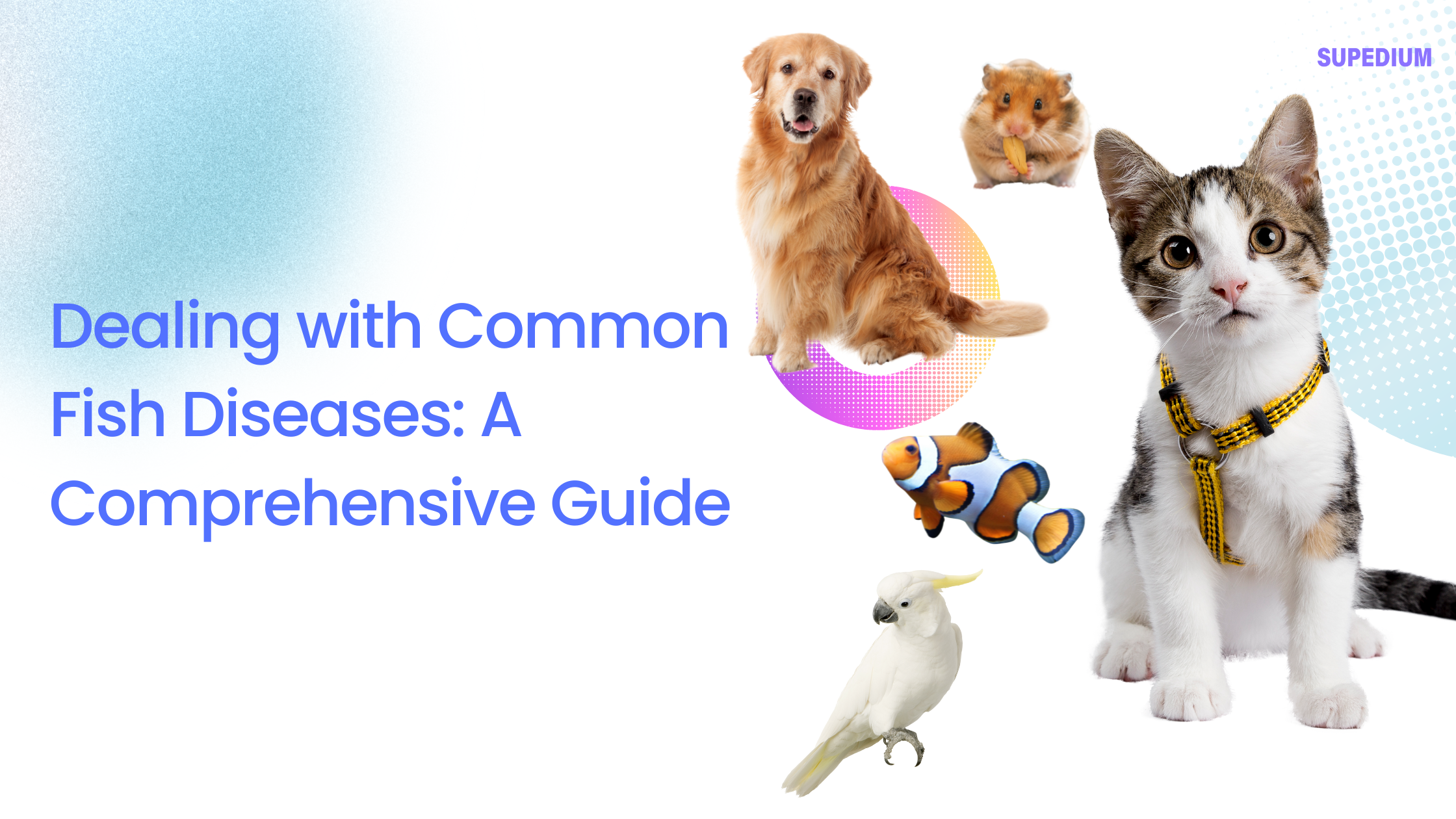Table of Contents
![]()
1. Introduction
Maintaining the health of fish in an aquarium is crucial for the well-being of the entire aquatic ecosystem. Healthy fish not only contribute to a balanced environment but also enhance the overall beauty and enjoyment of the aquarium. Recognizing and addressing common fish diseases early can prevent widespread issues and ensure a thriving aquatic habitat. This guide explores various fish diseases, their causes, diagnosis, treatment, and prevention strategies to help aquarium enthusiasts maintain optimal fish health.
2. Understanding Fish Diseases
2.1 Disease Classification
Fish diseases can be broadly classified into four categories: bacterial, viral, parasitic, and fungal. Each category has unique characteristics and requires specific treatment approaches.
- Bacterial Diseases: These are caused by harmful bacteria and can lead to severe infections if not treated promptly. Examples include fin rot and columnaris.
- Viral Diseases: Viruses can cause various symptoms and often lead to chronic or fatal conditions. Lymphocystis and viral hemorrhagic septicemia are common examples.
- Parasitic Diseases: Parasites can infect fish externally or internally, causing a range of issues from skin irritations to internal damage. Ich and velvet are frequent culprits.
- Fungal Diseases: Fungi can infect fish through wounds or compromised immune systems, leading to conditions like mouth fungus and saprolegnia.
2.2 Causes of Fish Diseases
The primary causes of fish diseases include:
- Poor Water Quality: High levels of ammonia, nitrites, or nitrates can stress fish and make them susceptible to diseases.
- Overcrowding: Too many fish in a tank can lead to poor water quality and increased disease transmission.
- Stress and Environmental Factors: Sudden changes in temperature, pH, or other environmental factors can weaken fish immune systems.
- Introduction of New Fish or Plants: New additions to the tank can introduce pathogens if not properly quarantined.
2.3 Symptoms of Illness
Fish may exhibit a range of symptoms when ill:
- Behavioral Changes: Lethargy, unusual hiding, or erratic swimming patterns.
- Physical Signs: Discoloration, lesions, or abnormal growths on the skin.
- Changes in Eating Habits: Loss of appetite or refusal to eat.
3. Diagnosis
3.1 Identifying the Disease
Accurate diagnosis is essential for effective treatment. Observing symptoms and correlating them with known disease patterns can help in identifying the illness.
3.2 Common Diagnostic Methods
- Microscopic Examination: Useful for identifying parasites and fungi.
- Water Quality Testing: Determines if poor water conditions are contributing to the disease.
- Skin Scrapings and Swabs: Collect samples for further analysis to identify specific pathogens.
3.3 Consulting Professionals
If symptoms persist or are severe, consulting a veterinarian specializing in fish health can provide a precise diagnosis and treatment plan. Engaging with local aquarists and experts can also offer valuable insights.
4. Treatment Strategies
4.1 General Treatment Principles
- Quarantine Procedures: Isolate infected fish to prevent the spread of disease.
- Medication Types: Depending on the disease, medications may include antibiotics for bacterial infections, antiparasitics for parasites, and antifungals for fungal issues.
- Dosage and Administration: Follow manufacturer instructions or veterinary advice to ensure effective treatment.
4.2 Treatment for Bacterial Diseases
- Common Infections: Fin rot, columnaris.
- Treatment Options: Use broad-spectrum antibiotics and ensure proper water quality to support recovery.
4.3 Treatment for Viral Diseases
- Common Infections: Lymphocystis, viral hemorrhagic septicemia.
- Supportive Care: While antiviral treatments are limited, maintaining optimal water conditions and providing a stress-free environment can help fish cope.
4.4 Treatment for Parasitic Diseases
- Common Parasites: Ich, velvet.
- Specific Treatments: Use antiparasitic medications as directed. Increasing water temperature can help in some cases, but consult guidelines for each specific parasite.
4.5 Treatment for Fungal Diseases
- Common Infections: Saprolegnia, mouth fungus.
- Treatment Options: Apply antifungal treatments and improve water quality to prevent fungal growth.
5. Prevention and Management
5.1 Maintaining Optimal Water Quality
Regular testing and maintenance are crucial. Ensure proper filtration, perform regular water changes, and monitor water parameters to prevent disease outbreaks.
5.2 Proper Nutrition
A balanced diet is vital for fish health. Avoid overfeeding and ensure fish receive a varied and nutritious diet to bolster their immune systems.
5.3 Quarantine and Acclimation
Quarantine new fish and plants before introducing them to the main tank. Acclimate them gradually to reduce the risk of disease transmission.
5.4 Stress Management
Minimize stress by maintaining stable water conditions, avoiding aggressive tank mates, and providing adequate space and hiding spots.
6. Special Considerations
6.1 Freshwater vs. Saltwater Fish
Different fish types have specific diseases and treatment protocols. Saltwater fish, for example, are more prone to certain parasites like marine ich, while freshwater fish might face issues like external fungal infections.
6.2 Species-Specific Diseases
Certain fish species are more susceptible to specific diseases. For instance, goldfish often suffer from fin rot, while bettas may be prone to velvet.
6.3 Aquatic Plants and Invertebrates
Plants and invertebrates can also impact fish health. Ensure they are disease-free and manage their conditions to prevent indirect effects on fish.
7. Case Studies and Examples
7.1 Real-Life Cases
Examining case studies of disease outbreaks can provide insights into effective management and treatment strategies. For example, an outbreak of ich in a community tank can illustrate the importance of quarantine and treatment protocols.
7.2 Lessons Learned
Analyzing past mistakes and successes in disease management can help improve practices. Avoiding common pitfalls, such as improper dosing of medications, is crucial for successful treatment.
8. Resources and Further Reading
8.1 Books and Manuals
Refer to reputable books and manuals on fish health for in-depth knowledge and treatment guidelines.
8.2 Online Resources
Websites, forums, and communities can offer additional support and information from experienced aquarists.
8.3 Professional Help
Consider consulting veterinary services and fish health specialists for complex or severe cases.
9. Conclusion
In summary, dealing with common fish diseases requires a thorough understanding of disease types, symptoms, and treatment options. By maintaining optimal water conditions, providing proper nutrition, and employing effective quarantine and treatment strategies, aquarium enthusiasts can promote the health and longevity of their fish. Responsible fish keeping involves continuous education and vigilance to ensure a thriving aquatic environment.
Share This





Be the first to comment